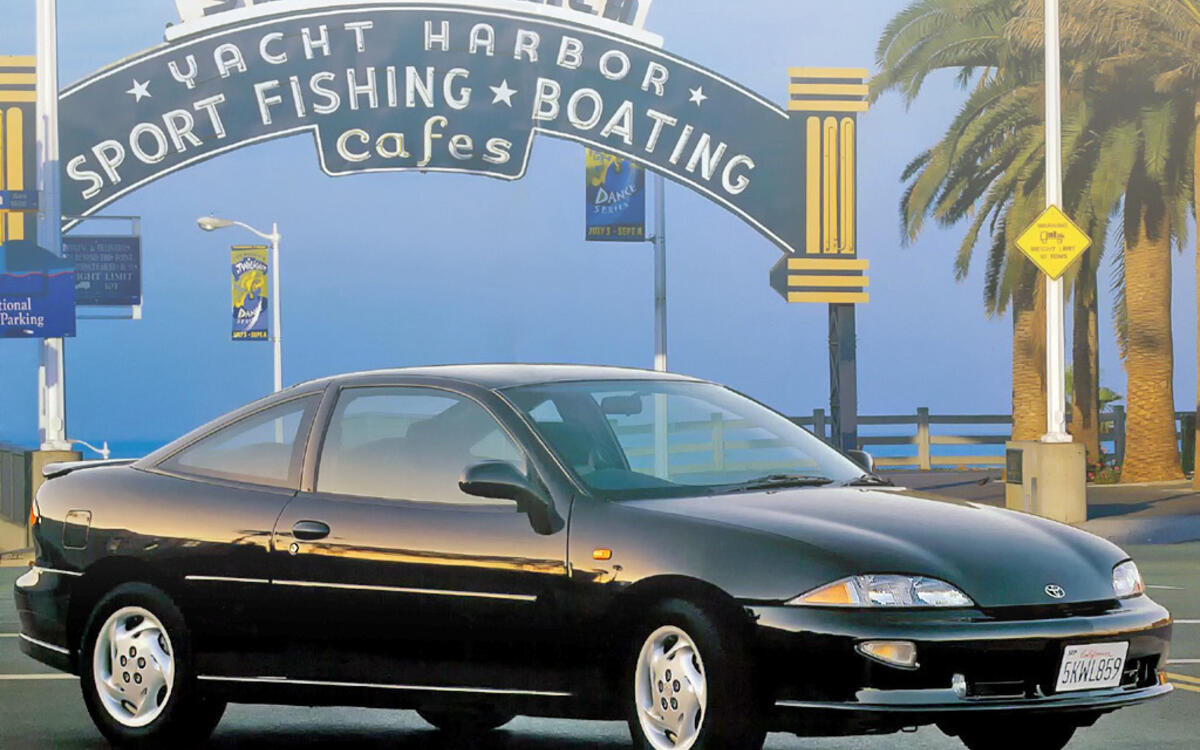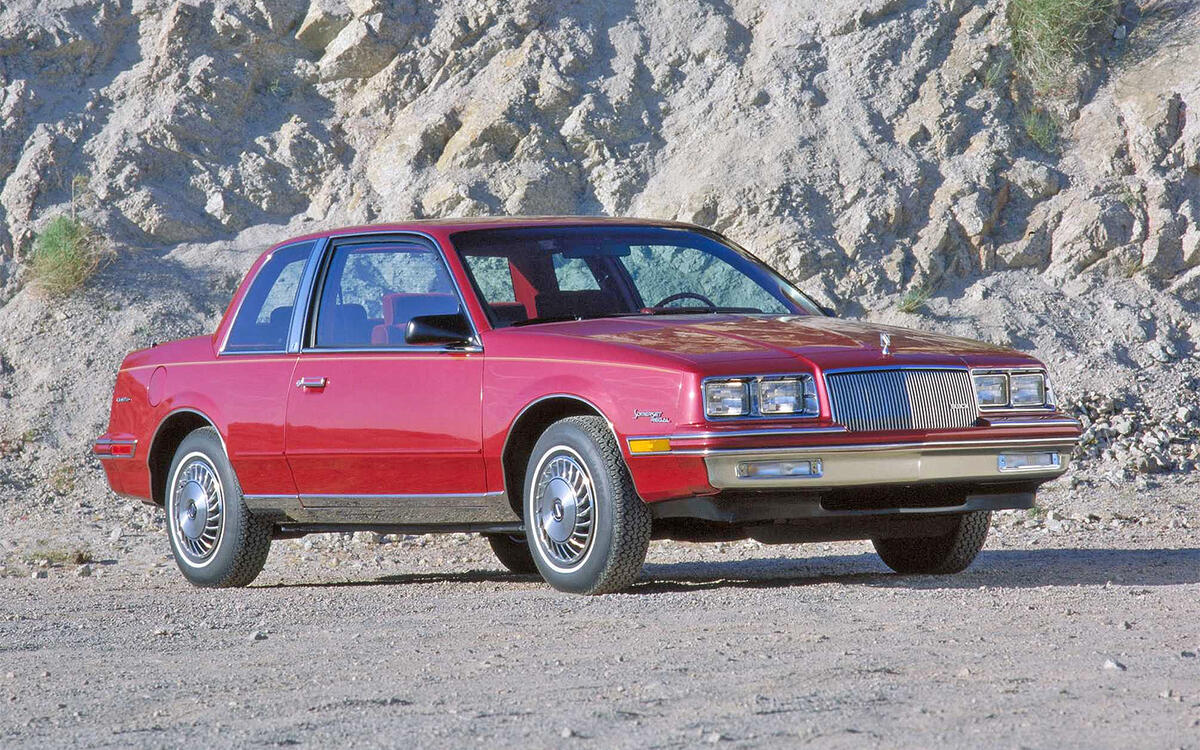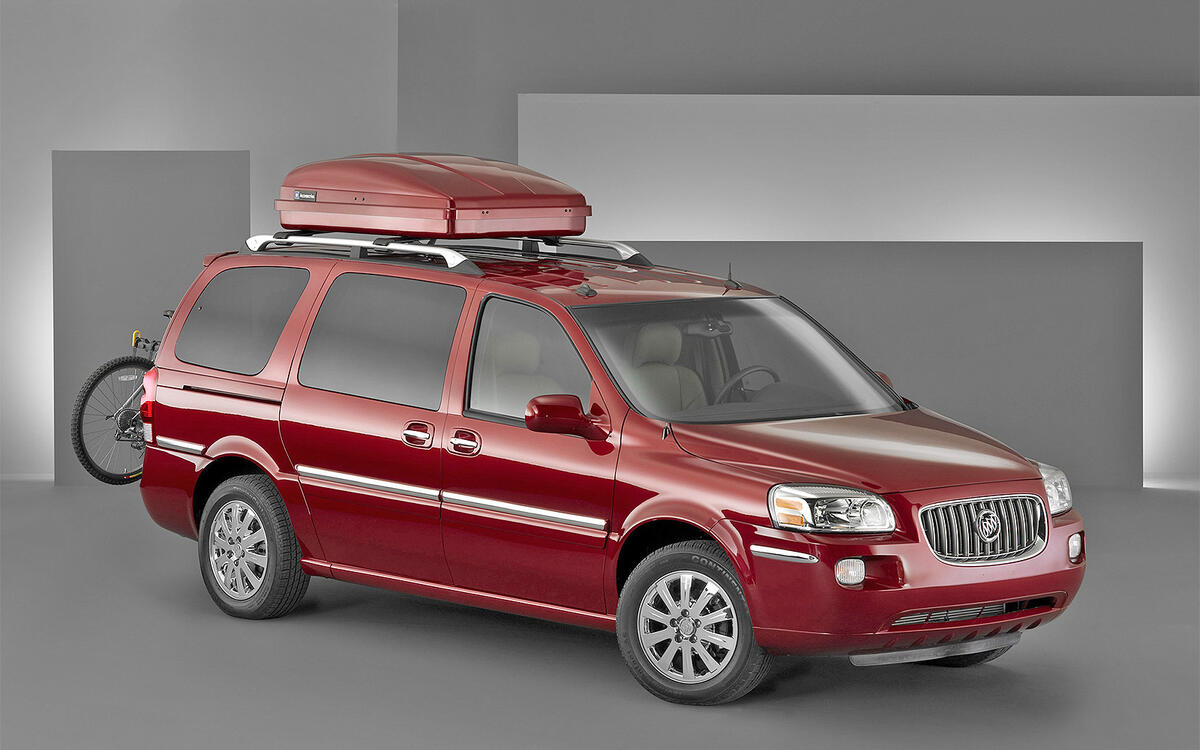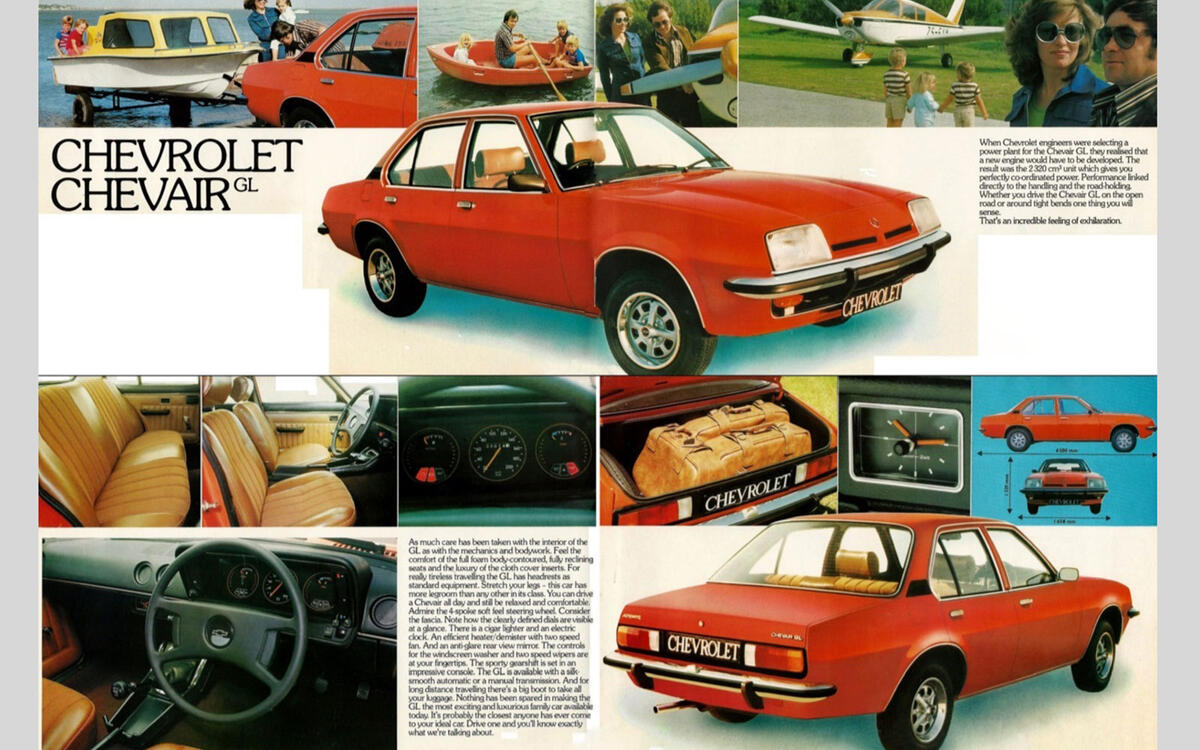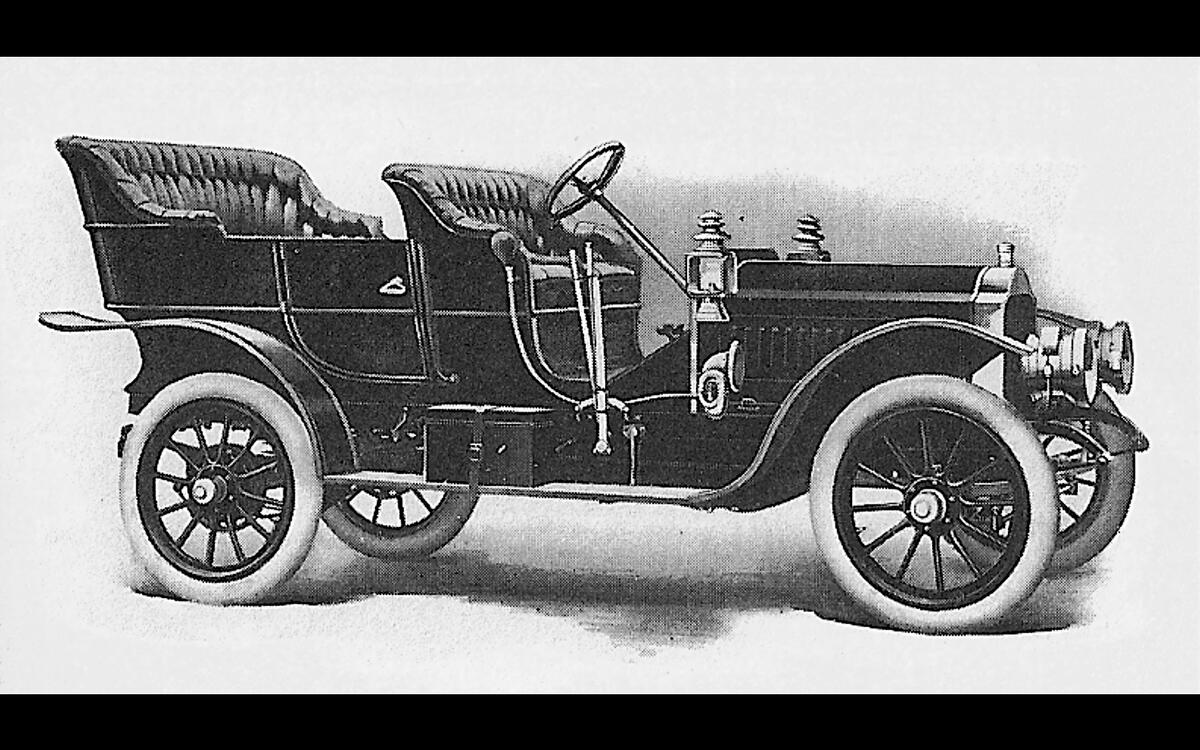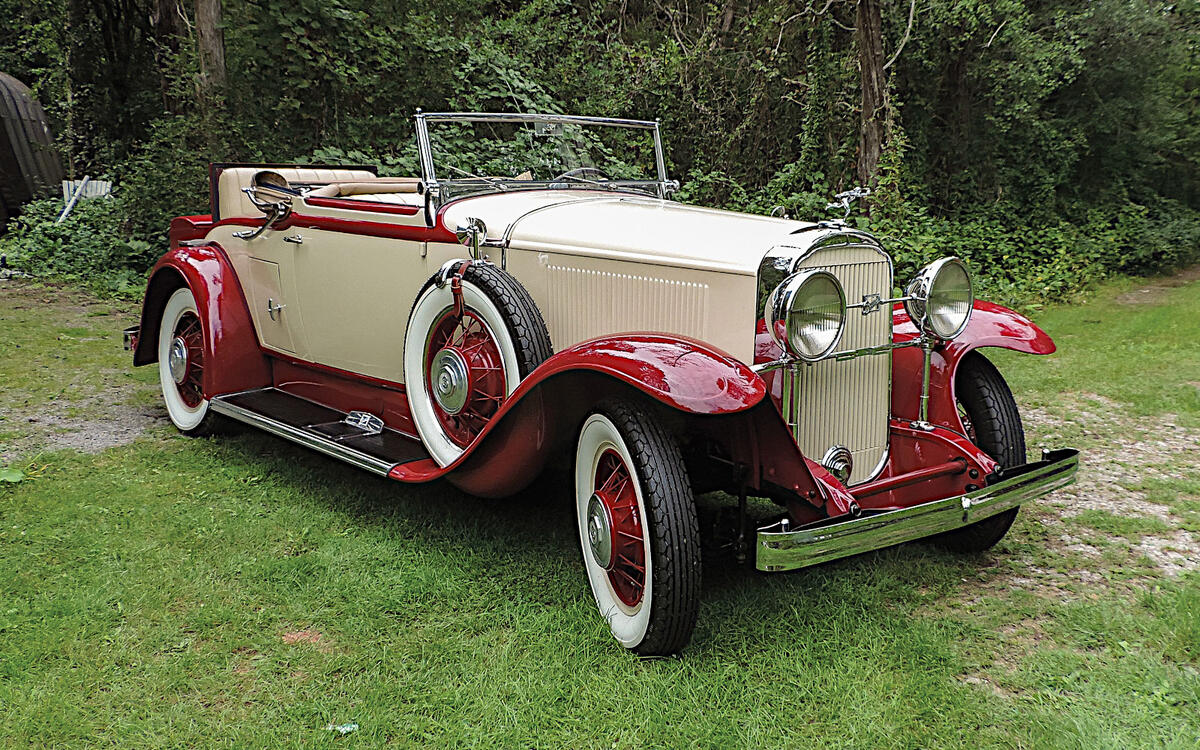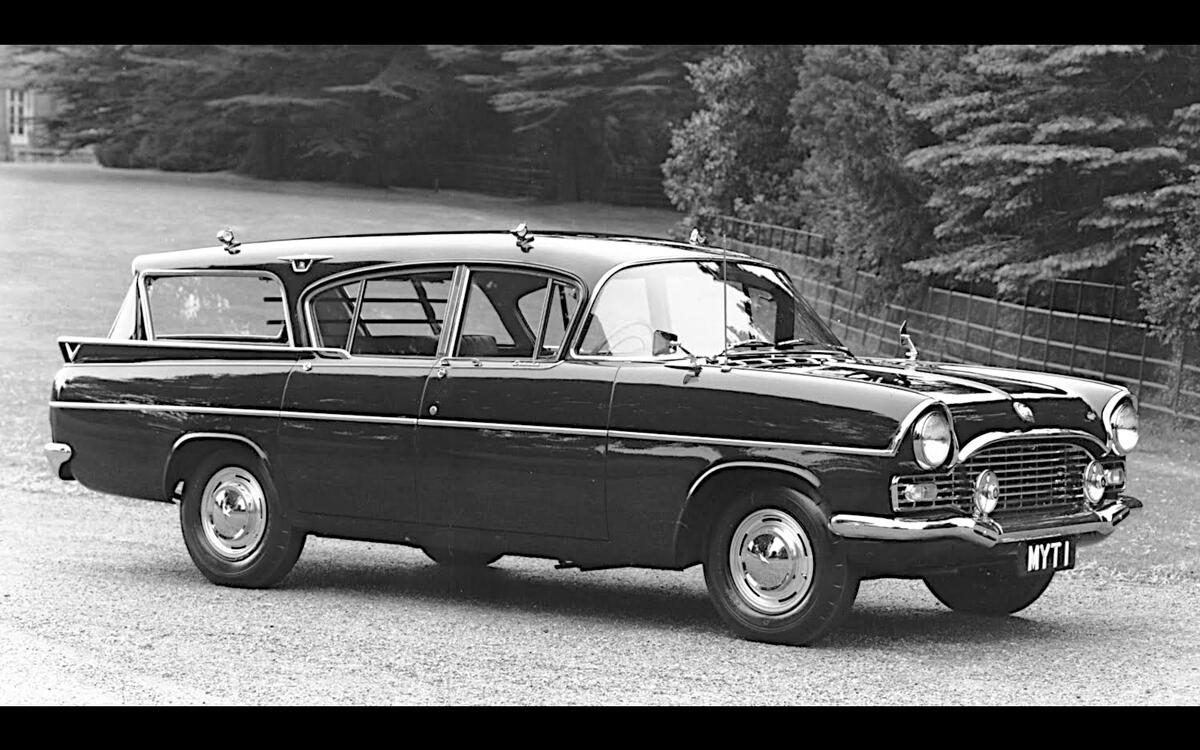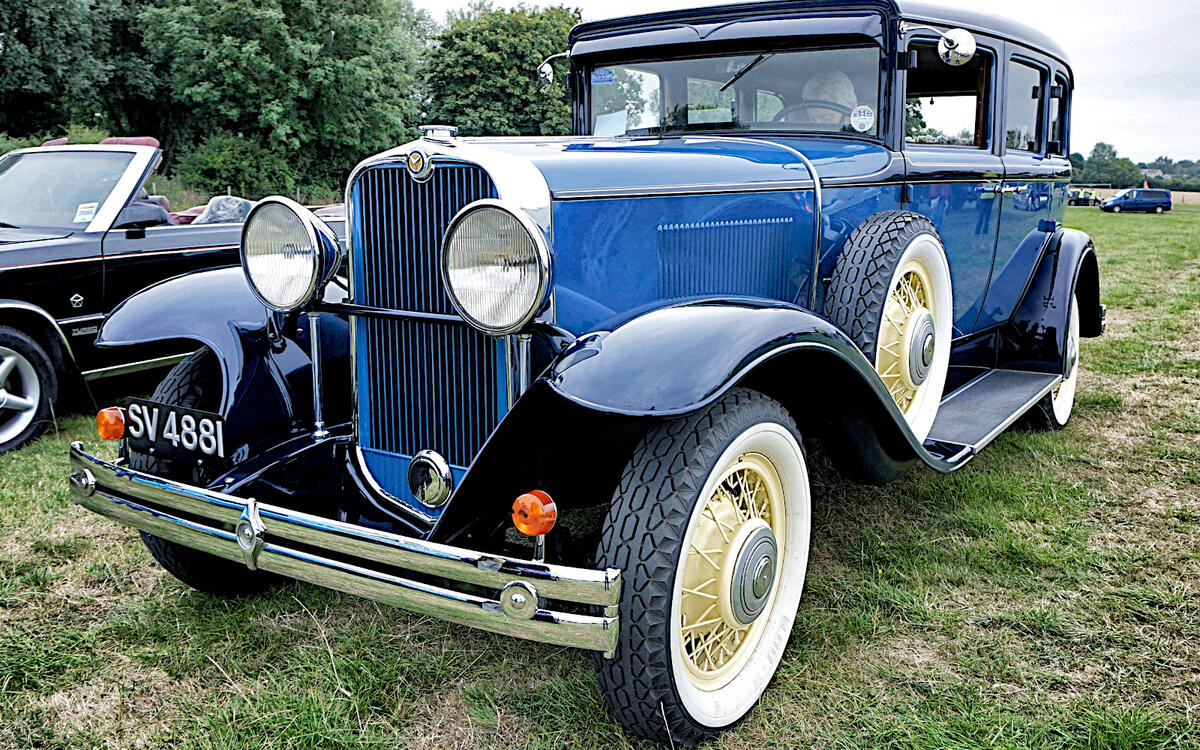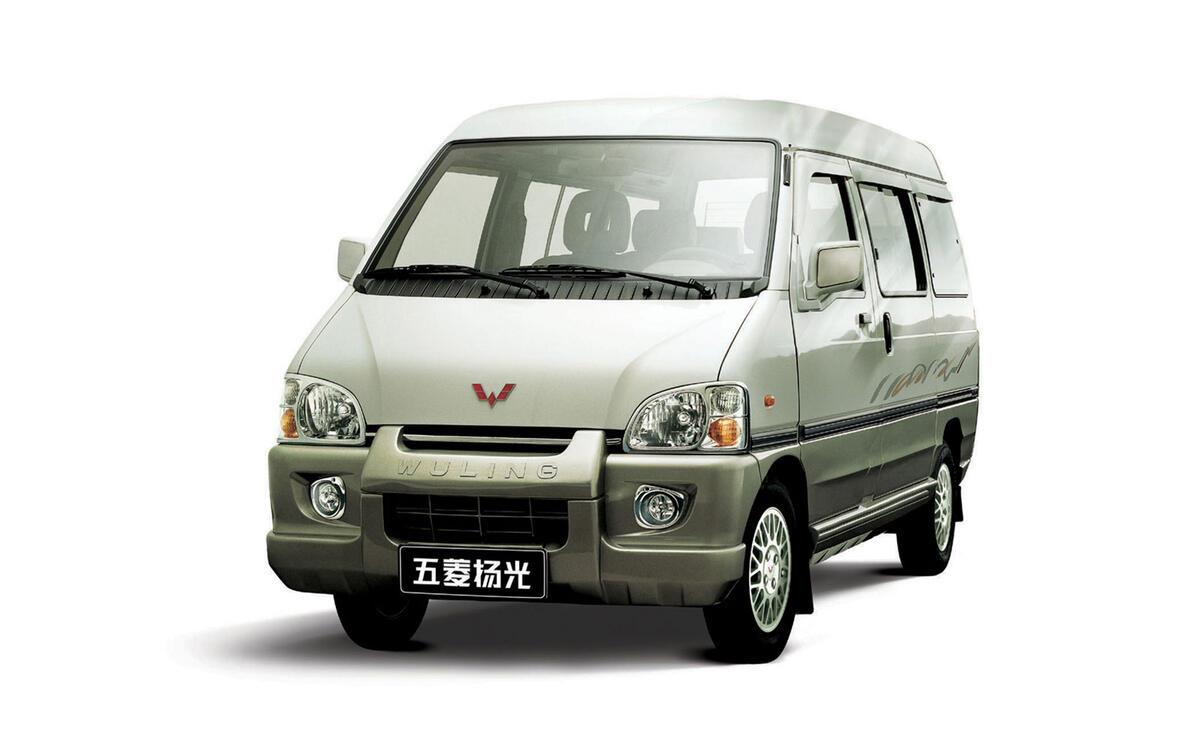 Slide of
Slide of
Founded in 1908, for decades General Motors was the world's biggest car maker with factories around the world.
Many of these churned out unique products for the local market. With divisions in South America, Africa and Asia as well as Europe, Australia and the US, these are just some of the GM obscurities that have probably passed you by – and a number were sold in North America. And yes you’re right – this GM-built car pictured here does wear a Toyota badge – and we'll explain why. You certainly get points for recognising any of these cars:
In alphabetical order
 Slide of
Slide of
Acadian Canso (1964)
The Acadian brand was created to allow GM to sell cars in Canada without incurring heavy tariffs. The Acadian Beaumont is one example. It was a slightly modified Chevrolet Nova built in Canada and available in Canadian dealerships which normally sold Pontiacs and Buicks. Acadian had been formed in 1962, and remained in operation for nearly a decade until 1971.
 Slide of
Slide of
Asüna Sunfire (1993)
The Sunfire was one of three Asian models sold in Canada under the short-lived Asüna brand in the early 1990s. It was a rebadged version of the car known in North America as the Isuzu Impulse and elsewhere as the Isuzu Piazza. Asüna's other products were the Sunrunner (Suzuki Vitara) and the SE/GT (Daewoo Le Mans).
 Slide of
Slide of
Beaumont (1965)
The Beaumont was part of the Acadian line-up until the 1966 model year, when it became a one-model brand in its own right. Other than that, not much changed. The car was based, as before, on the Chevrolet Chevelle, and could still be purchased from Canadian Pontiac-Buick dealers.
 Slide of
Slide of
Buick Century Turbo coupé (1979)
The seventies was a torrid decade for car makers, thanks to a dramatic increase in fuel prices and demands from legislators for lower emissions and improved safety. Turbocharging became more fashionable and in 1978 GM's Buick division introduced the Regal and LeSabre coupés with turbocharged 3.8-litre V6 engines intead of naturally aspirated V8s. Then in 1979 came the Buick Century Turbo coupé, which struck a decent balance between economy and performance – but just a few were built before production was halted after just one year.
 Slide of
Slide of
Buick Excelle (2003)
When GM acquired Daewoo in 2002, after the latter had gone bust, the former teamed up with Chinese car maker SAIC. Within a year the Daewoo Lacetti had been revived, but facelifted and relaunched as the Buick Excelle. As a compact saloon it sat above the Buick Sail, powered by either a 1.6 or 1.8-litre petrol engine.
 Slide of
Slide of
Buick Invicta (1958)
"The most spirited Buick", as its maker described it, was a full-size model available with several body styles and a powerful 6.6-litre V8 engine. It created quite a stir when it made its debut in the 1959 model year, but by 1963 it was being offered only as a station wagon. The large, high-performance Buick model was now the Wildcat, and the Invicta name was quietly dropped soon afterwards.
 Slide of
Slide of
Buick Sail (2000)
Three months after the Chevrolet Celta went on sale, the first Buick Sails started to roll off the production line in China. The Buick Sail was the Chinese take on the Opel Corsa B but it didn't come in hatchback form – instead there were only four-door saloons and five-door wagons available, powered by 1.2, 1.4 or 1.6-litre petrol engines.
 Slide of
Slide of
Buick Somerset (1985)
The Somerset was a two-door coupe derivative of the Buick Skylark saloon. It was originally known as the Somerset Regal, but became simply the Somerset after an update in 1987. Despite a high-spirited ad campaign ("Give me savvy, give me cool, give me a car that breaks all the rules!") Buick abandoned the name in 1988 and marketed the car from then on as part of the Skylark range.
 Slide of
Slide of
Buick Terraza (2004)
Although the Terraza has a small claim to fame as the first Buick minivan sold in North America, it was really the same thing as the Chevrolet Uplander, Pontiac Montana SV6 and Saturn Relay. All of them struggled against the Japanese opposition and had short production lives - just three years in the case of the Buick.
 Slide of
Slide of
Cadillac BLS (2007)
Cadillac is synonymous with large luxury cars and is one of the most American brands of all. So when GM decided to design and build a compact Cadillac just for Europe and based on the Saab 9-3, most grounded onlookers assumed that the project would end in tears. And sure enough it did, with the Cadillac BLS saloon and wagon selling in tiny numbers before Cadillac retreated once again. It was the only Cadillac never sold in the US.
 Slide of
Slide of
Cadillac Castilian
The Castilian is one of the most obscure Cadillacs ever produced, largely because Cadillac had very little to do with it. In the mid 1970s, Traditional Coach Works of California converted around a dozen Fleetwood saloons into sumptuous - and enormously expensive - station wagons. In a further example of eccentricity, Traditional also reworked the Coupe de Ville into the Mirage pickup.
 Slide of
Slide of
Cartercar (1908)
Cartercar is one of the least well-known of all General Motors brands. It was established in 1905 and bought three years later by GM founder William Durant (1861-1947), largely because of its friction drive transmission. Durant was ousted from GM in 1910, and by the time he bought his way back in, Cartercar had been discontinued. "They say I shouldn't have bought Cartercar," he grumbled. "Well, how was anyone to know that Carter wasn't to be the thing? It had the friction drive and no other car had it. How could I tell what these engineers would say next?"
PICTURE: 1908 Model D Roadster
 Slide of
Slide of
Chevrolet 1300 (1976)
GM has a habit of offering the same bodyshells around the globe, but with market-specific styling and engine options. In 1976 it unveiled a Firenza-based hatchback for the South African market, known simply as the 1300. Featuring unique body pressings aft of the B-pillar (but with a Vauxhall Chevette tailgate to cut costs), the Chevrolet 1300 was a sales disaster, with buyers not at all willing to buy a three-door compact hatch.
 Slide of
Slide of
Chevrolet 1700 (1972)
GM's first major joint venture was with Korean car maker Shinjin. The collaboration began in 1972 and the first fruit was the Chevrolet 1700, based on the Holden Torana LJ, which was offered in saloon, wagon and pick-up forms. A facelift in 1976 led to the Chevrolet branding being ditched as a new marque was launched instead: Saehan, with the 1700 also being rebranded as the Camina.
 Slide of
Slide of
Chevrolet Celta (2000)
GM went on a major expansion drive in Brazil at the start of the new millennium, with a new factory opened. Known as the Gravatai Complex, GM claimed that it was the world's most efficient car factory, and one of its core products was the Celta, a reworked Opel Corsa. While the Celta wasn't especially interesting technically, it was notable for being the first car that GM Brazil tried to sell online – which was cutting-edge in 2000.
 Slide of
Slide of
Chevrolet Chevair (1977)
GM South Africa didn't have much luck selling its own version of the Vauxhall Viva HC, so in 1976 it introduced a new compact family saloon, based on the first-generation Vauxhall Cavalier/Opel Ascona. To make it more appealing to the local market a Manta B front end was grafted on – although in 1978 the Chevrolet Ascona was introduced, using the same nose as the Opel original.
 Slide of
Slide of
Chevrolet Citation (1979)
Although it was a big seller in the early days, the Citation is remembered with little fondness in North America nowadays, and hardly at all elsewhere. It started out as a very popular US answer to the wave of front-wheel drive Japanese compacts, but problems soon became apparent: dubious build quality, a problem with the rear wheels locking under braking and the fact that examples lent to the media to test seemed much better put together those bought by customers.
Sales crumbled, and the once heralded Citation disappeared in 1985 after being in production for just five years.
 Slide of
Slide of
Chevrolet Comodoro (1975)
The Opala range proved hugely successful for GM Brazil, and in time there would be ever more luxurious versions introduced, along with coupé and wagon editions with the latter called the Caravan; shown here is the extent of the 1978 Opala model range. At the top of the range was the Gran Luxo which in 1975 was spun off as a separate model called the Comodoro, with a six-cylinder engine. It even had a clock, radio and vinyl roof as standard. That was some serious luxury.
 Slide of
Slide of
Chevrolet Corvair Greenbrier (1961)
With a low-slung flat-six engine tucked away behind the rear axle and no propshaft running down the centerline, the Chevrolet Corvair was a natural candidate for conversion into a series of utility vehicles. One of these was the Corvan which, with additional windows and seats, was transformed into the ingenious Greenbrier. Unfortunately, after a good start, sales soon withered away, partly because of opposition from the cheaper Ford Econoline and Volkswagen Type 2. Production came to an end in 1965, only four years after it began.
 Slide of
Slide of
Chevrolet Delray (1958)
The Delray name was used for a trim level for a few years before being applied to a specific model in 1958. Available as a two- or four-door saloon, or as a delivery van, the Delray was a type of vehicle we don't see nowadays, being very large but also cheap and sparsely equipped. There was a market for that sort of thing at the time, but very few Delrays exist now because production lasted for only one year. From 1959, the space-for-your-buck Chevy was the Biscayne.
 Slide of
Slide of
Chevrolet Firenza Can Am (1973)
The Vauxhall Firenza was one of those seventies coupés that was all mouth and no trousers. While it looked reasonably stylish, its 1159cc four-cylinder engine was pretty gutless. In South Africa the Firenza was sold as a Chevrolet, and to compete in racing there, GM built a 5.0-litre V8-powered Firenza called the Can-Am, 100 examples of which had to be built for homologation purposes. The Camaro Z28 engine provided a 143mph top speed with 0-62mph taking just 5.4 seconds. Some ended up fettled for rallying too, as pictured.
 Slide of
Slide of
Chevrolet Impala Fuelie (1958)
The second-generation Impala was not obscure by any measure, unless it happened to be a Fuelie. This was the nickname for 1959 model year examples with fuel injection. Chevrolet had abandoned injection the year before due to problems in hot weather, but a few Impalas left the factory with the system fitted all the same. Estimated production numbers range from 19 to 37, but whatever the true figure was there's no doubt that these are spectacularly rare cars.
 Slide of
Slide of
Chevrolet S-10 EV (1997)
Like the Impala, the S-10 pickup truck was a very common vehicle, but only if it had an internal combustion engine. The all-electric EV was an exception. Fewer than 500 are believed to have been built in the late 1990s, all using a similar powertrain to the GM EV1. Of all Chevy pickups, this is the rarest by some margin.
 Slide of
Slide of
Chevrolet Yenko Nova (1969)
Pennsylvania Chevrolet dealer and racing driver Don Yenko (1927-1987) was known for developing extreme versions of the cars he sold. The rarest was a second-generation Nova fitted with a 7.0-litre V8 engine and sold in the late 1960s. Fewer than 40 of these monsters were built during a period when Chevrolet itself was producing over 200,000 Novas annually.
 Slide of
Slide of
Chevrolet Opala (1969)
With its hefty import taxes, Brazil has its own car industry, because bringing cars in from outside is simply too costly. As a result, an array of cars exist uniquely in this South American country, with the Chevrolet Opala being, one of them, built between 1969 and 1992. Based on the Opel Rekord, the Opala was GM Brazil's first locally manufactured and engineered car, available only as a four-door saloon with four- or six-cylinder petrol engines.
 Slide of
Slide of
Chevrolet Sprint (1985)
In most parts of the world this small hatch was sold as the Suzuki Cultus or Swift, but for a while in the mid-eighties it assumed a whole raft of GM identities. In Canada and some parts of the USA it was marketed as the Chevrolet Sprint but in Australia it was the Holden Barina – and in Canada it was also available as the Pontiac Firefly.
 Slide of
Slide of
Chevrolet Yeoman (1958)
Chevrolet introduced a raft of nameplates that became legendary through the fifties and sixties, but the Yeoman was not among them. Available with straight-six or V8 engines, the Yeoman was a Delray-based station wagon with either two or four doors, both capable of carrying six people. As an entry-level model the Yeoman sold poorly and was canned after just one season, in which fewer than 20,000 examples were sold.
 Slide of
Slide of
Daewoo G2X (2007)
Daewoo went bust in 1999 and two years later GM bought up the automotive division, Daewoo Motor. The result was a company called GM Daewoo, marketed as a budget car brand – so a Daewoo version of the car sold in the US as the Pontiac Solstice and Saturn Sky, and in Europe as the Opel Speedster, was pretty unexpected. Unveiled in 2007, the Daewoo G2X was sold only in South Korea.
 Slide of
Slide of
Daewoo Imperial (1989)
By the start of 1983 the Saehan brand had been dropped in favor of Daewoo, which got ideas above its station when it introduced Korea's first luxury car in 1989. The Daewoo Imperial was an evolution of the Royale and it came only with a 3.0-litre straight-six as seen in Europe’s Opel Senator. Extremely highly specified, the Imperial was available for five years but just a few hundred examples were sold in that time.
 Slide of
Slide of
Daewoo Maepsy (1982)
When the Saehan brand was set up Korea, one of its first products was the Gemini, based on the Opel Kadett/Vauxhall Chevette – GM's first world car. Only a four-door saloon was offered, with a 1.5-litre Opel overhead-cam four-cylinder petrol engine. In 1982 the Gemini name was switched to Maepsy but very soon after, the Saehan brand was retired too, with Daewoo then taking over.
 Slide of
Slide of
Elmore (1900)
Although its cars were very different, Elmore's story is very similar to that of Cartercar. It became a division of General Motors in 1908 during a William Durant buying spree, and was abandoned after Durant ouster in 1910. If Durant had been in control throughout this period, GM might conceivably have become a leader in the development of two-stroke engines, which were Elmore's speciality.
PICTURE: Elmore Model 40
 Slide of
Slide of
El Morocco (1956)
Canadian businessman Reuben Allender (1897-1966) converted two Chevrolet models - the Bel Air in 1956 and the smaller Two-Ten in 1957 - to make them look like Cadillacs, and somehow managed to have them registered under the El Morocco brand name. The idea was to offer some of the Cadillac experience to people who could not afford the real thing, forgetting that GM solved that problem a long time previously with the Buick brand. Around 20 were built, of which few survive. Today, they are highly regarded by Chevrolet collectors, though less so by Cadillac enthusiasts.
PICTURE: 1957 convertible
 Slide of
Slide of
GMC Chevette (1992)
Though not particularly distinguished in itself (it was one of the many GM T-body cars and therefore related to the Vauxhall Chevette and the Isuzu Piazza), this car is outstanding both for its rarity outside its home continent and for its existence within the brand's line-up. It is the only saloon ever marketed as a GMC, which normally sells trucks, vans and SUVs. It was built from 1992 to 1995 by General Motors of Brazil, and sold predominantly in Argentina.
 Slide of
Slide of
Holden Scurry (1985)
The eighth-generation Suzuki Carry was marketed in Australia from 1985 to 1987 ad the Holden Scurry. Although Holden’s involvement didn’t extend far beyond swapping badges and transporting it to dealerships, the Scurry has an unusual claim to fame - at 970cc, its engine is the smallest ever fitted to any vehicle sold by GM's Australian brand.
 Slide of
Slide of
Hummer H1 Slantback (1994)
The H1 was essentially the civilian version of the Humvee military vehicle developed by AM General. Some versions of the Humvee had an almost coupe-like shape, referred to as slantback. The same profile was also used for the H1, but very rarely. Only around 40 genuine H1 slantbacks are believed to have been produced, though other H1s have been converted to look like them.
 Slide of
Slide of
Kia Elan (1995)
This one is slightly tenuous in that GM owned Lotus when the front-wheel drive Elan (M100) was introduced in 1989, the acquisition having taken place in 1986. Just seven years later Lotus was then sold to Bugatti owner Romano Artioli, and two years after that, in 1995, the rights to build the Elan were sold to Kia. Available only in Kia's home market of South Korea, the Elan enjoyed a second lease of life between 1996 and 1999.
 Slide of
Slide of
LaSalle (1927)
In the late 1920s, General Motors nearly doubled its number of automotive brands in North America by creating what were known as companions for four of its five then current makes. Cadillac's companion was LaSalle, which managed to survive throughout the Great Depression despite having GM's second most expensive model line.
LaSalles are rare now, partly because its cars appealed to a relatively small number of customers and partly because production lasted for only 13 years before being canceled in 1940.
PICTURE: 1929 Convertible Coupe
 Slide of
Slide of
Marquette (1929)
GM used the Marquette name briefly before the First World War, then revived it for the Buick's lower-priced companion make in 1929. The six models (mechanically identical but with different body styles) seemed promising, but a combination of the stock market crash and Buick's decision to introduce an entry-level car of its own brought production to a halt after just one year. In that time, over 38,000 were built, around one-tenth of them in Canada.
PICTURE: 1930 Phaeton
 Slide of
Slide of
McLaughlin (1908)
Established as a carriage manufacturer in 1867, McLaughlin is now almost forgotten, but it has an important place in GM history. It began building Buick-engined cars in 1908, and ten years later it was incorporated into General Motors Canada. Its later models were known as McLaughlin-Buicks, but after the Second World War the McLaughlin name was dropped and the cars were sold simply as Buicks.
PICTURE: 1931 McLaughlin-Buick Series 90 Convertible Coupe
 Slide of
Slide of
Oakland (1907)
Oakland is the subject of the strangest chapter in the story of GM's companion makes programme. It was founded in 1907, and was joined in 1926 by the newly formed Pontiac. Pontiac's cars were both cheaper and more popular than Oakland's, and it remained in business until 2010. Oakland, the only brand to be outlived by its younger partner, was discontinued in 1931.
PICTURE: 1929 Landaulet Sedan
 Slide of
Slide of
Oldsmobile Jetstar I (1963)
The powerful Jetstar I two-door hardtop was a low-priced alternative to the Oldsmobile Starfire and a rival to the Pontiac Grand Prix. Pontiac easily won that battle in 1964, and continued to do so after both cars were updated the following year. The Jetstar's very short career came to an end when Oldsmobile moved the Starfire downmarket in 1966.
 Slide of
Slide of
Opel GT (1968)
This pretty little sports coupe was one of the rarest and most unusual vehicles Opel ever produced, but most classic car enthusiasts will have heard of it. However, a high proportion of them may believe it was only ever powered by the 1.9-litre Cam In Head engine, when in fact it was also available with the 1.1-litre sidevalve unit which originally appeared in the first-generation Kadett in the early 1960s. This was by far the less popular choice, and was discontinued in 1970, making the 1.1-litre model an obscure car even by Opel GT standards.
 Slide of
Slide of
Pontiac Grand Prix Super Duty (1962)
The 6.9-litre Super Duty version of Pontiac's V8 engine was available only as a dealer-fitted option in 1961, but started to become available from the factory in the following year. Its rarest application was in the '62 Grand Prix - only 16 examples of this model are believed to have been built, which may have had something to do with the fact that the engine on its own cost well over half as much as an entire entry-level Grand Prix. The official output of 405 horsepower, impressive though it sounds, is now regarded as a hilarious underestimate.
 Slide of
Slide of
Saab 9-2X (2004)
When the 9-2X was launched in 2005, Saab was wholly owned by GM, which also had a 20% stake in Subaru parent Fuji Heavy Industries. Combining the two brands made perfect sense to GM, if nobody else. The result was an Impreza Wagon with a Saabified nose and tail, extra soundproofing and more orthopaedic seats. But within a year GM had bailed out of Fuji Heavy Industries and the 9-2X was canned with just over 10,000 made.
 Slide of
Slide of
Saab 9-4X (2004)
Much rarer than the 9-2X was the Saab 9-4X, which was launched in 2010 and by the end of 2011 had been axed with just 800 or so examples produced. Effectively a rebodied Cadillac SRX, the 9-4X was based on GM's four-wheel drive Theta platform and came with a choice of 2.8 or 3.0-litre V6 petrol engines. Incidentally, the 9-4X was the only Saab to be built in Mexico.
 Slide of
Slide of
Saehan Rekord (1975)
The Opel Rekord had been built in Korea as early as 1973, just a year after GM set up shop there, working in conjunction with Shinjun. Those early Korean Rekords were identical to their German counterparts, but in August 1975 came the arrival of the Saehan brand which brought a raft of small design changes to make this executive saloon more appealing to local tastes. Two models were offered: the entry-level Premier and the range-topping Royale, talking of which…
 Slide of
Slide of
Saehan Royale (1978)
Picking up where the Opel Rekord D-based Saehan Rekord Royale left off, the Rekord E-based Saehan Royale arrived in 1978. Buyers could choose between petrol and diesel engines and just one bodystyle: a four-door saloon that from 1983 would be sold as the Daewoo Royale.
 Slide of
Slide of
Scripps-Trunkh
Perhaps the most obscure of all the GM brands, Scripps-Trunkh manufactured cars between two years which are not agreed on by all sources, but may have been 1914 to 1922. Owners are reported, with little in the way of supporting evidence, to have included Winston Churchill and several members of European royalty, but there is no doubt that Groucho Marx bought a used example because he was fascinated by the way its door opened at the press of a button. He was less impressed when five pushrods fell out of the engine within the first few miles.
PICTURE: 1917 Type C Roadster
 Slide of
Slide of
Toyota Cavalier (1995)
Produced between 1982 and 2005, the Cavalier was a budget family compact saloon that was uninspiring but affordable, so it proved a good seller for Chevrolet. GM also built the Cavalier in its Lordstown, Ohio, factory, for Toyota to sell in its home market. Utterly devoid of character, the Toyota Cavalier was offered for five years – not that it proved popular with buyers. The Lordstown factory was sold to Lordstown Motors in 2019, which plans to build electric pickups there.
 Slide of
Slide of
Vauxhall Cresta/Velox wagon
The PA series Cresta and its slightly less well-equipped Velox variant were built by Vauxhall only as saloons, but some examples were sent to Friary Motors based in Basingstoke, England, to be converted into wagons. These are now rare, and one in particular is unique. It was built specially for Queen Elizabeth II and included a dog guard and a gun rack. Oddly, it had neither Cresta nor Velox branding.
The Vauxhall badge above the front grille suggested it should be a Cresta, but it had the more downmarket interior upholstery of the Velox, perhaps because this would be cheaper to repair in the event of an attack by corgis.
PICTURE: the Royal Vauxhall
 Slide of
Slide of
Vauxhall Sportshatch (1976)
The Vauxhall Firenza-based Droop Snoot, built between 1973 and 1975, is reasonably well known. The plan was to build at least 1000 each year, but the total ran to just 204, which left Vauxhall with a lot of unwanted glassfiber nose cones. The solution was to graft these on to a Magnum wagon and despite the fact that the Sports Hatch was never officially listed as a production model, 197 were sold – just seven fewer than the official Droop Snoot.
 Slide of
Slide of
Viking (1929)
Viking was the only one of GM's four companion makes placed higher in the market than its partner, which in this case was Oldsmobile. All Vikings were built on the same chassis and used the same V8 engine, but there was a choice of body styles. Whatever the merits of these cars, they were even less successful than the contemporary Marquettes - only around 7000 were produced from 1929 to 1931.
 Slide of
Slide of
Welch (1910)
Welch must hold the record for existing for the least time as a General Motors brand. It had been building powerful, technically sophisticated luxury cars for several years before being taken over in 1910. While this might have been seen at the time as a route to greater success, GM in fact shut it down in 1911.
PICTURE: 1908 Model 4-L
 Slide of
Slide of
Wuling Sunshine (2002)
Chinese company Wuling was set up in 1958 to build machinery; by 1964 it had started to produce tractors. Jump forward two decades and GM bought into Wuling which by now was making microbuses, which were immensely popular in China. Working with GM, Wuling introduced the Sunshine microbus in 2002 and it quickly became a best seller, thanks to its ability to carry eight adults – despite being just 147in in length.
The Sunshine is still in production with hundreds of thousands made every year. GM today is by far the most successful of the Big Three in China, though local competition is growing.
Access control:
Open

